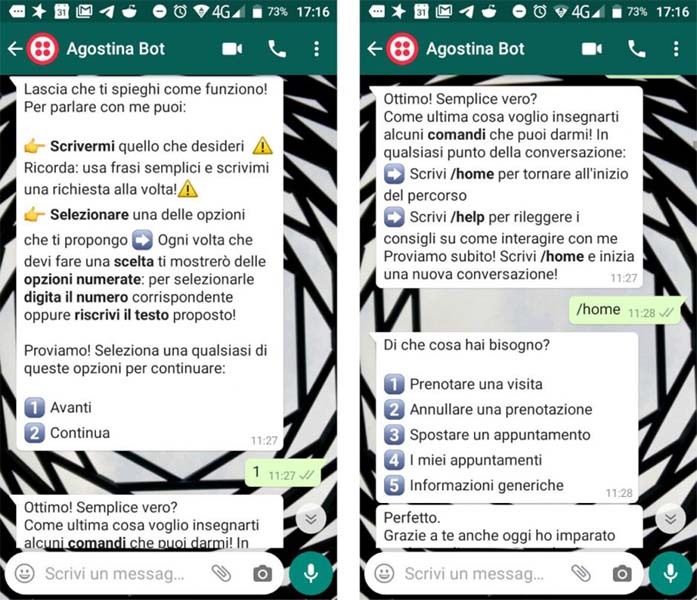Since the beginning, Heres had the integration with WhatsApp, the most popular messaging app, on its roadmap. This was only possible thanks to the integration with Twilio, a Whatsapp partner. Today we can finally say that all of this is possible: the new Heres’ channel has arrived!
The added value of this channel
We can now offer to our clients another channel, where they can integrate their chatbot without giving up the ones that they already have on other touchpoints, such as Facebook, their website or external applications.
In order to use this app we developed the integration with Twilio, another popular messaging platform. In this way we can manage better all the messages sent and received; moreover this app allows reducing set-up times for every new project and, at the same time, it provides higher efficiency on a chatbot’s response time.
WhatsApp is a useful additional tool, which offers some interesting advantages, such as:
- It’s a familiar channel for all kinds of users, without distinction of age, gender, status, level of knowledge about technology;
- It’s an application, that is already installed on almost every smartphone. You just have to save the chatbot contact information and it immediately becomes a virtual assistant, easily accessible, such as Google Assistant;
- It allows to stay always connected to user profiles, if the client’s id includes his/her telephone number;
- It could be personalized in order to have a unique conversational experience, different for every user;
- It’s an app that everybody uses a lot during the day, so it’s almost certain that users are going to open the message and interact with it.
Whatsapp VS Webchat, a comparison of two interfaces
WhatsApp presents a lot of technical and conversational peculiarities, so we developed new solutions and at the same time we used the tool we already had in an innovative way. In particular, we can see in detail how WhatsApp is different from our Webchat, the graphic interface that we created.
Welcome Message:
The first difference we can see is in the welcome message, which is the first message that starts a conversation between a user and a chatbot. On our Webchat it’s usually the bot that interacts first, introducing itself as a virtual assistant and describing to the user how it can help him.
Instead, on WhatsApp is the user that make the first move, writing the first message to the bot. That’s pretty much like a normal conversation, in which you add a new contact and you have to write first. The chat opens indeed empty without any welcome message from the bot.
This kind of interaction could be disadvantageous and it could be confusing, if it’s not correctly managed. Without a welcome message, the user might think he’s talking with a human being and probably doesn’t understand what the chatbot knows.
In order to prevent confusion or misunderstandings, we took some particular strategies, such as:
- If the bot doesn’t understand the user’s request, it answers with a brief presentation, in which it describes what it can do and the main conversational paths.
- The bot is ready to answer to specific questions about what it can do and what it is. This is particularly important when user can feel disoriented like in this case.
- There is also the possibility to watch a tutorial, which explains the main bot’s characteristics and how user can use them in the best way.

Guided Conversational Flows
On our Webchat the interaction is developed in different coexistent alternative ways. In order to choose between the solutions presented by the bot or to have a specific information, the user can click on a quick reply or write a sentence in natural language. If you want to know more about this topic, here’s the article on our blog.
The chatbot can answer using alternative forms too. For example cards, images, graphic tools or interactive widgets. In this way the conversation is clear and smooth.
The quick reply selection is a very useful tool, which is crucial in some conversational flow points. The click selection is faster when users have to choose between different options of the same set.
For example:
- Choice of a solution in a time or price slot.
- Choice of a category of products.
- Choice of an availability slot for an appointment (hour, date, place…)
- Choice of a product (name, description, price, size…)
On WhatsApp choice options are represented only in a text-base format. For this reason, we made improvements on the technical and on the graphic side. In particular:
- We developed a heuristic algorithm that allows to choose between different options using strings of text. This algorithm allows to trigger an action, which usually refers to a quick reply, only if the text is considered as similar to the one of a quick reply. Moreover, this algorithm allows to manage the synonyms, alternative or incomplete wording and the numeric choice selection: you can choose every option by using the corresponding number (“1”, “the first one”…)
- In order to teach the user how to take advantage of this WhatsApp mechanism, we have established that before every kind of option there is an emoji related to the topic: this method is easy and effective, moreover it makes very clear how to use the chatbot.
- In order to represent complex objects, we have established a sort of “emoji dictionary”: every attribute is related to a specific emoji, so that there is an immediate content clarity.
So why do we have to choose to integrate WhatsApp?
WhatsApp is the most used messaging platform in the world and so it is an essential tool for Customer Service. WhatsApp allows an easy clear and familiar communication for everybody, so that it is a channel which simplifies the interactions with the public and it makes the potential lead of a company bigger.
Besides its limits, this new channel represents a new growth opportunity for companies and technology. WhatsApp is leading the way to Innovation and it is reducing more and more the human-machine distance of chatbots in Customer Service.
Would you like to know more?
If you are interested in integrating WhatsApp channel for your chatbot, let's keep in touch.



